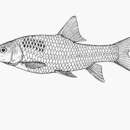fr
noms dans le fil d’Ariane


Labeobarbus altianalis (Syn.: Barbus altianalis), Englisch Ripon Barbel[1], in Uganda Enzuguli, in Ruanda Inkwekwe und in Kenia Fwani genannt, ist eine große afrikanische Barbenart.[2]
Labeobarbus altianalis hat folgende Flossenformel: Dorsale 9–11, Anale 5–6. Die vordere Bartel kann bis an die mittlere Augenhöhe reichen, ist jedoch in der Regel sehr kurz. Die hinteren Barteln sind länger. Die Lippen sind stark ausgeprägt.[2] In den ostafrikanischen Seen wurden Exemplare bis 18 Kilogramm und etwa 110 Zentimetern Länge gefangen.[3]
Labeobarbus altianalis ist in Ostafrika beheimatet. Sie kommt in Kenia, Tansania, Ruanda, Burundi, Uganda und Kongo vor.[2] Die Fischart ist im Lake Kiwu, dem Ruzizi-Fluss bis zum Flussdelta[4], Akagera unterhalb der Rusumo Falls vor. Außerdem findet man die Fischart im Eduardsee, Victoriasee und Kyogasee.[2]
Labeobarbus altianalis bevorzugt Gewässer mit Sand- oder Kiesgrund. Jungfische halten sich überwiegend in Fließgewässern auf, während adulte Tiere sowohl in Flüssen als auch in Seen leben. In Seen dienen hauptsächlich Mollusken als Ernährungsgrundlage, während Insektenlarven in hartgründigen Gewässern eine große Bedeutung in der Ernährung von Labeobarbus altianalis besitzen. Die Tiere fressen außerdem pflanzliche Nahrung, Krebstiere und kleine Fische. Pflanzenreste überwiegend von Jungfischen. Barbus altianalis ist ovipar.[2]
Labeobarbus altianalis ist Speisefisch und Sportfisch vor allem in der Region um den Kagera River.[2]
Labeobarbus altianalis gehört aufgrund seines weiten Verbreitungsgebietes und seiner omnivoren Ernährungsgewohnheiten derzeit nicht zu den bedrohten Fischarten in Afrika. Lokale Populationen können jedoch kurzfristig durch Erosion nach Kahlschlag in den umliegenden tropischen Regenwäldern und der damit verbundenen Eintrübung der Gewässer kurzfristig in Mitleidenschaft gezogen werden. Stark mit Sedimenten angereicherte Gewässer bieten kaum Wachstumsgrundlage für Unterwasserpflanzen und somit auch wenig Überlebenschancen für die Jungfische. Labeobarbus altianalis gehört zu den langsam wachsenden Fischarten und benötigt daher auch relativ lang, um geschlechtsreif zu werden. Eine zunehmende unkontrollierte Überfischung am Kagera River könnte ebenfalls zu einer Bedrohung werden.[2]
Labeobarbus altianalis (Syn.: Barbus altianalis), Englisch Ripon Barbel, in Uganda Enzuguli, in Ruanda Inkwekwe und in Kenia Fwani genannt, ist eine große afrikanische Barbenart.
The Ripon barbel (Labeobarbus altianalis) is an East African ray-finned fish species in the family Cyprinidae. A notably large barb, its maximum recorded total length is 90 cm (35 in).[1]
Like other African "barbs", placement of this species in Barbus – the genus of the typical barbels and relatives – was provisional. Though called "barbel", it is probably not closely enough related to the typical barbels – the core group of Barbus – to be considered congeneric. Several supposedly distinct species have been merged into B. altianalis, and numerous subspecies have been proposed. None of these are deemed valid. Some authorities place this species in the genus Labeobarbus. On the other hand, B. longifilis, B. paucisquamatus and B. somereni were once considered subspecies of L: altianalis, the second as sspp. lobogenysoides and paucisquamata and the third as ssp. urundensis.[2]
Significant junior synonyms of L. altianalis are:
L. procatopus was described from the Amala River, which was mistakenly believed to be to the east of Lake Baringo. The Ripon barbel does not occur there, and the taxon was thus thought to refer to Labeobarbus intermedius. But the Amala is actually a tributary of the Mara River, where L. altianalis is found, and L. procatopus is thus a junior synonym of it.[1]
The Ripon barbel inhabits Lake Victoria and its drainage basin and surrounding areas in the East African Rift, including Lake Edward, George, Kyoga and Kivu, and the Ruzizi River down to its delta (though not adjacent Lake Tanganyika) and the upper and middle Kagera River. Records from the Tana River are in error. The countries in which it is found are Burundi, Democratic Republic of the Congo, Kenya, Rwanda, Tanzania and Uganda.[1]
It lives in diverse freshwater habitats, from inshore waters of lakes to rapidly flowing rivers. This species is an omnivore, eating water plants, molluscs and fishes. It is fished for sport and food; its Kagera River population being of some commercial significance.[1]
Widespread and apparently rather plentiful for such a large fish due to its ecological tolerance and omnivorous habits, the Ripon barbel is not considered a threatened species by the IUCN. Local stocks might be temporarily affected by erosion after deforestation increasing turbidity and upsetting the aquatic plant life, and unsustainable growth of the fisheries e.g. along the Kagera must be avoided considering that it is presumably – as per its large size and like many relatives – slow-growing and takes long to mature.[1]
The Ripon barbel (Labeobarbus altianalis) is an East African ray-finned fish species in the family Cyprinidae. A notably large barb, its maximum recorded total length is 90 cm (35 in).
Barbus altianalis es una especie de peces de la familia de los Cyprinidae en el orden de los Cypriniformes.
Los machos pueden llegar alcanzar los 90 cm de longitud total.[2]
Es un pez de agua dulce.
Se encuentra en los lagos Kivu y Victoria.
Barbus altianalis es una especie de peces de la familia de los Cyprinidae en el orden de los Cypriniformes.
Barbus altianalis Barbus generoko animalia da. Arrainen barruko Actinopterygii klasean sailkatzen da, Cyprinidae familian.
Barbus altianalis Barbus generoko animalia da. Arrainen barruko Actinopterygii klasean sailkatzen da, Cyprinidae familian.
Labeobarbus altianalis é uma espécie de peixe actinopterígeo da família Cyprinidae.
Pode ser encontrada nos seguintes países: Burundi, República Democrática do Congo, Quénia, Ruanda, Tanzânia e Uganda.[3]
Os seus habitats naturais são: rios, pântanos, lagos de água doce, marismas de água doce e deltas interiores.[3]
Está ameaçada por perda de habitat.[3]
Labeobarbus altianalis é uma espécie de peixe actinopterígeo da família Cyprinidae.
Pode ser encontrada nos seguintes países: Burundi, República Democrática do Congo, Quénia, Ruanda, Tanzânia e Uganda.
Os seus habitats naturais são: rios, pântanos, lagos de água doce, marismas de água doce e deltas interiores.
Está ameaçada por perda de habitat.